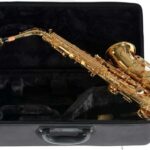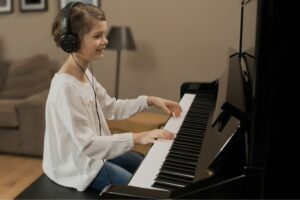When you play its keys, there is a digital keyboard that you feel like you are playing the keys of a real concert grand piano. It is also the best for its price point. In this Yamaha P-85 review, I will list all its features and specs to help you see if the digital piano is right for you.
The Yamaha Corporation launched the Yamaha P-85 in 2007. It was an entry-level digital keyboard that introduced a MIDI sequencer. This digital piano succeeded the Yamaha P-70. Among its features are 10 various patches, natural piano touch response, and dynamic, high-quality sounds.
Its being touch-sensitive makes the Yamaha P-85 very wonderful to play. The sensitivity of its keyboard can also be adjusted to suit your playing style. Yamaha calls it Graded Hammer technology, which enables its keys to offer authentic piano touch.
Read on to learn more about the Yamaha P-85, its features and specs, and everything you need to know to determine if it is the digital piano you are looking for.
About the Yamaha P-85
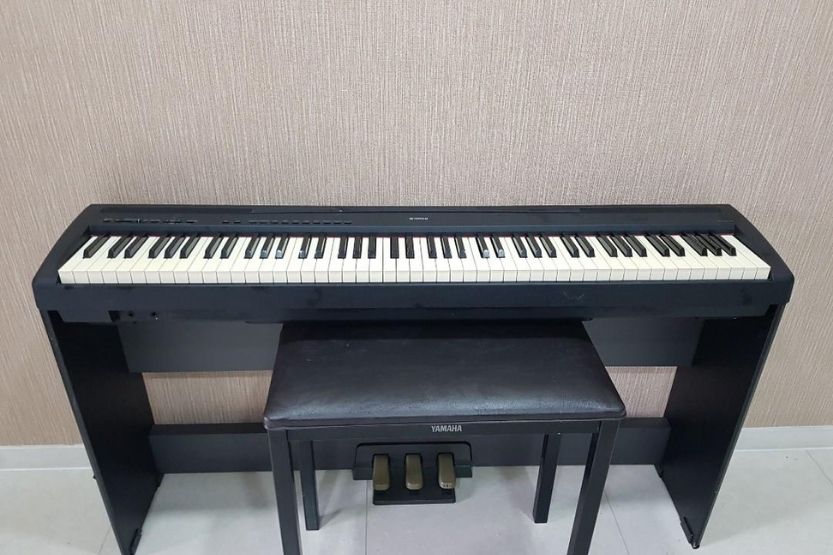
Yamaha Corporation’s P Series
The Yamaha P-85 belongs to the P series digital pianos made by Yamaha Corporation. It is an entry-level keyboard that succeeded the Yamaha P-70 and also introduced a MIDI sequencer. This digital piano comes with 10 various voices or patches, and it also uses multi-sampling. Some of the patches are rendered in stereo.
At this time, the Yamaha P-85 can be considered as already outdated. But still, there are lots of piano sites where you can buy or sell this item. The Yamaha P-85 is now primarily used as a practice piano.
Touch Sensitive Yamaha P-85
One good thing about the Yamaha P-85 is that it is touch-sensitive. The sensitivity of its keyboard can be adjusted according to your style of playing. It uses Graded Hammer technology, which enables it to provide authentic touch when you play its keys.
The keys of the Yamaha P-85 are weighted. So, when you play it, you will feel like you are playing a standard piano. You can also add some foot pedals if you really want to have the complete feeling of playing a full piano.
The Yamaha P-85 belongs to the P Series digital pianos of Yamaha Corp. This series offers high-quality and dynamic sound, complete with the natural piano touch response expected of all-acoustic Yamaha standard pianos. The digital piano versions are equipped with built-in stereo speaker systems of high quality packed in a stylish and slim portable design.
The keyboard of the Yamaha P-85 is a full 88 keys. So, it can suit any skill level, from beginners to professionals. It comes with 10 various patches consisting of the following:
- Electric pianos (2),
- Acoustic pianos (2),
- 2 church organs,
- 2 harpsichords,
- 1 vibe, and
- 1 string.
Some of these patches use multi-sampling and are in stereo.
As already mentioned, it uses Graded Hammer technology or GHS (Graded Hammer Standard). Yamaha Corp. manufactured this digital piano from 2007 to 2010. Its tag price at that time was $600.
Yamaha P-95
The Yamaha P-85 was succeeded by the Yamaha P-95 when it ceased production in 2010. As such, its parts are no longer supported by the company. However, the Yamaha P-85 with problems can refer to online service manuals that offer detailed schematics.
Some PCBs are well-marked that will enable anyone who has certain electronics background to fix basic problems of the Yamaha P-85 as it grows in age.
Key Features of the Yamaha P-85
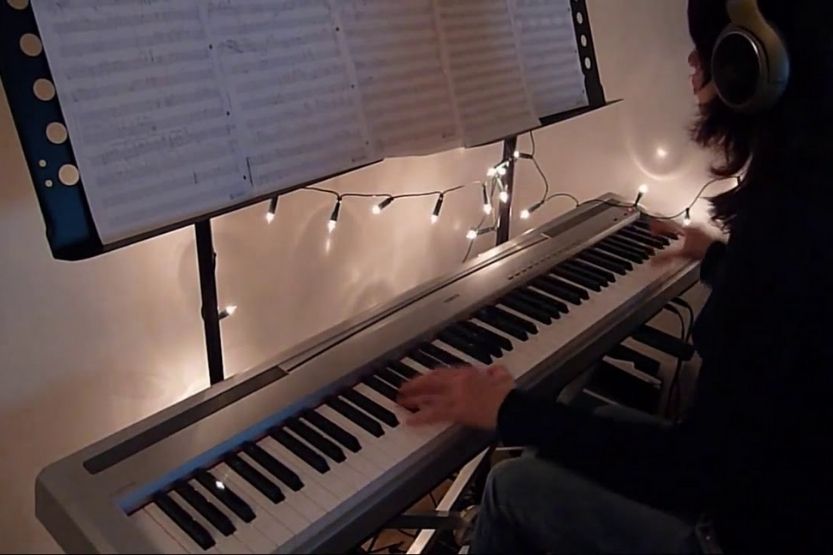
The Yamaha P-85 has many features that will amaze you if you learn to play a digital piano. But some features stand out among the others. What follows are detailed descriptions of these features:
1. Acoustic Piano Feel
If you want to buy an acoustic piano but can’t afford to pay the price, your best option is the Yamaha P-85. It’s not thousands of dollars but only around $600, and you get the feel of a standard high-quality piano.
This digital piano comes with 88 keys. It uses GHS or Graded Hammer Standard. Simply put, this technology provides weighted hammer action that will give you a realistic feel to its keyboard. The sound timber also changes according to how hard you press its keys. With this feature, the Yamaha P-85 can really capture the sound and feel of an acoustic piano.
2. High Quality Sound
The sound produced by the Yamaha P-85 is of very high quality. It uses AWM stereo or Advanced Wave Memory stereo. This is a detailed digital sampling of a full concert grand piano. The sound changes in volume and tone according to the way you play the keys.
The AWM works in tandem with the GHS to provide you with a keyboard that produces authentic piano sounds in a lightweight package that weighs just about 25 pounds.
3. Compact and Stylish Design
The Yamaha P-85 does not take too much space and is not very heavy to take along anywhere. It has a slim and lightweight design that can fit any room décor. The stereo speakers are already built-in. These speakers are enough to fill a medium-size room with high-quality sounds.
4. Extensive Voice Selection
This digital piano comes with various voices (patches) that include organs, electric pianos, harpsichords, strings, and a dual voice feature that allows you to play two voices simultaneously. All in all, there are 10 voices in the Yamaha P-85. They include the following:
- 2 grand pianos – one piano with bright sounds and one concert grand piano
- Electric pianos (2) – dynamically or straight sensitive
- 2 harpsichords – layered or straight with the same voice one octave higher (but is not touch sensitive)
- 2 pipe organs – one with a ‘coupler’ and one with three choirs for producing Baroque sounds
- Strings
- Vibraphone
5. Preset Songs
There are 50 great selections of songs in a Yamaha P-85. It comes with an impressive list of full piano pieces. They include the following:
- Debussy
- Joplin
- Schumann
- Mozart
- Chopin
- Beethoven
- Bach
Additionally, the 10 voices of the P-85 have demo songs that you can preview.
6. Recording
The Yamaha P-85 also allows you to record your practice sessions or your personal songs as it can store up to 11,000 notes. You can send your musical data to a MIDI or a computer device. But you can’t transfer the preset songs. For data transfer, you can use a USB device and a USB cable adapter.
This digital piano uses a one-track recorder. It is beneficial when you are creating music. You can record a song and listen to it later to determine the sections you need to improve. To record your work, press the record button to start the recording.
Whenever you need to stop, press the button again, and your recording will stop. A red light will keep on flashing as you are recording your work. It stops flashing when you stop the recording.
7. Layering
You can layer two sounds in the Yamaha P-85. So, you can hear the two-layered sounds simultaneously. The process is really very simple. This is how you do it in this digital piano:
- Choose any two tones that you want to layer. For instance, you can choose a grand piano and a string.
- Press the buttons of these two selections.
- When you touch the keys of the keyboard, you will hear the layered sound of a grand piano and a string.
8. Half-pedal Effect
The Yamaha P-85 also features half-pedal control. That means this digital piano allows you to have greater acoustic-like control over the sound it makes. So, you can play this piano with more creative expression. But this is only possible if you use the optional LP-5 Pedal Unit or the FC3 Foot Controller.
9. Excellent Speakers
The sound quality of the stereo speakers of the Yamaha P-85 is also impressive. However, they have minimal volume, so increasing the sound intensity may affect the sound quality of these speakers over time.
These speakers are also mounted at the bottom of the keyboard. Their acoustic sound could be improved if you put the keyboard on a keyboard stand instead of just putting it on top of a solid surface table.
Again, what makes the Yamaha P-85 unique? The Yamaha P-85, an entry-level piano made by the Yamaha Corporation in 2007, launched the MIDI sequencer. Its features include 10 patches, natural piano touch response, and dynamic, high-quality sounds.
Standard Features of the Yamaha P-85
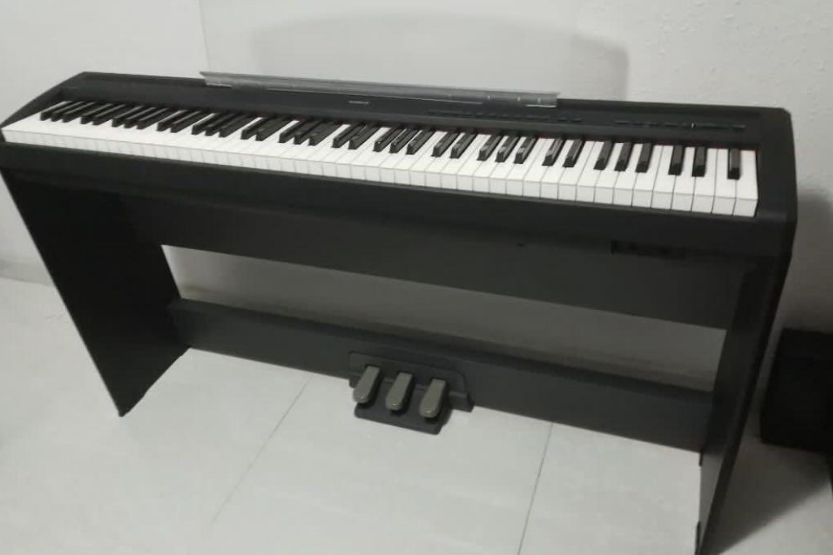
To provide you a complete picture of what you can have with the Yamaha P-85, here are its standard features:
- Keys – complete 88 keys
- Polyphony – 64 notes
- Touch Sensitivity – GHS (graded Hammer standard), 3 velocity settings, or off
- Stereo System – AWM (advanced wave memory) stereo
- Reverb/chorus – 4 reverb settings and 1 chorus
- Metronome – equipped, from 32 to 280 BPM (beats per minute)
- Amplifier – 6 watts
- Recorder
- Built in 10 patches and 50 demo songs
- Half-damper effect with the optional LP5 pedal unit or the FC3 pedal
- MIDI input/output
- MSRP – $600
Specifications of the Yamaha P-85
Here are the full specifications of the Yamaha P-85:
- 88 key Graded Hammer Standard keyboard (A1-C7)
- 10 voices
- 64-note max polyphony
- 10 voice demos/50 piano preset songs
- Reverb and chorus effects
- AWM stereo sampling engine
- Metronome
- 1-track recording/playback
- 6W x 2 stereo sound
- Sustain pedal jack (FC5 pedal included)
- MIDI I/O
- Headphone jack
- Dimension (Width x Height x Depth) – 52 3/16” x 11 5/8” x 5 15/16”
- Weight – 25 pounds and 9 ounces
Conclusion: Yamaha P-85
The Yamaha P-85 is an entry-level digital keyboard that Yamaha Corp. launched in 2007. It succeeded the Yamaha P-70 and also introduced a MIDI sequencer. This digital piano has many amazing features that make it a good buy for beginner and middle-level pianists.
Among its remarkable features is graded hammer action that translates into a natural piano touch response. This digital piano comes with 10 various patches and dynamic, high-quality sounds. For its price point, the Yamaha p-85 is a good buy.
Read next:

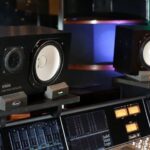
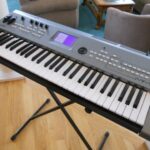
![Yamaha Grand Pianos [Specs and Review] Yamaha Grand Pianos](https://musicalinstrumentpro.com/wp-content/uploads/2021/08/Yamaha-grand-pianos-150x150.jpg)
![Yamaha Hybrid Pianos [Specs and Review] Yamaha Hybrid Pianos](https://musicalinstrumentpro.com/wp-content/uploads/2021/08/Yamaha-Hybrid-Pianos-150x150.jpg)
![Yamaha Upright Pianos [Specs and Review] Yamaha Upright Pianos](https://musicalinstrumentpro.com/wp-content/uploads/2021/08/Yamaha-Upright-Pianos--150x150.jpg)
